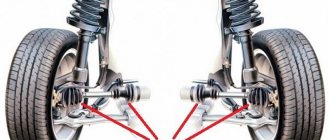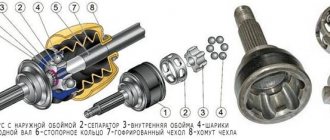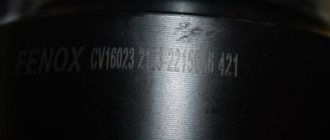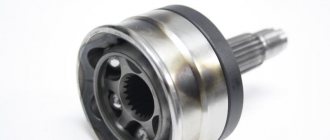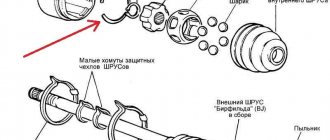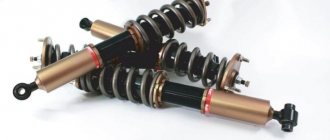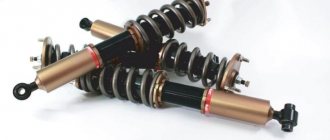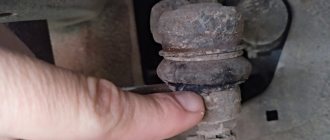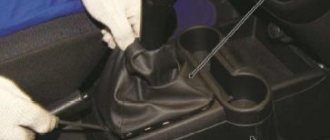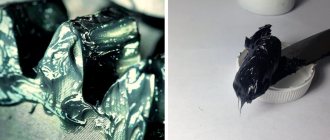The widespread use of constant velocity joints began with the serial production of cars with front-wheel drive. The goal was to create a device, different from a cardan with a differential, capable of transmitting rotation to the drive front wheels directly from the engine. Moreover, in conditions of constant turning of these wheels.
But any mating parts with a large dynamic load are inevitably affected by a large friction force. This means lubrication is needed. The result was the appearance of viscous and at the same time plastic lithium compounds, the most typical representative of which is lithol (although lithol is not used as a CV joint lubricant).
Types of lubricants for CV joints
Lubricants are produced based on various chemical compositions.
Let us list and characterize the types currently used. LM47 lubricant for CV joints with molybdenum disulfide
Lithium CV joint greases
These are the oldest lubricants that began to be used immediately after the invention of the hinge itself. They are based on lithium soap and various thickeners. Depending on the base oil used, lubricants can range in color from light yellow to light brown. They are well suited for use at medium to high temperatures. However, at low temperatures they lose their viscosity, so the level of protection of the mechanism is significantly reduced. It is even possible for the hinges to tap during extreme cold.
Traditional Litol-24 also belongs to lithium lubricants, but it cannot be used in CV joints.
CV joint grease with molybdenum
With the advancement of technology, the use of lithium greases has become largely ineffective. Therefore, the chemical industry has developed more modern lubricants based on lithium soap, but with the addition of molybdenum disulfide. As for the lubricating properties, they are approximately the same as those of lithium analogues. However, a feature of molybdenum lubricants is their high anti-corrosion properties. This became possible thanks to the use of metal salts in their composition, which replaced some of the acids. Such compositions are absolutely safe for rubber and plastic, from which some CV joint parts are made, in particular the boot.
Usually, when purchasing a new boot, it comes with a disposable bag of lubricant. Be careful! According to statistics, there is a high chance of running into a fake. Therefore, before using the lubricant, check its consistency by pouring a small part of it onto a sheet of paper. If it is not thick enough or is suspicious, it is better to use another lubricant.
A significant disadvantage of molybdenum-based lubricants is their fear of moisture. That is, if even a small amount of it gets under the boot, the lubricant with molybdenum turns into an abrasive with the ensuing consequences (damage to the internal parts of the CV joint). Therefore, when using molybdenum grease, it is necessary to regularly check the condition of the boots on the CV joint body, that is, its tightness.
Some unscrupulous sellers say that joint lubricants with a molybdenum additive restore the damaged joint. This is wrong. If a crunching noise appears in the CV joint, it must be repaired or replaced at a service station.
Popular products from this series in our country are CV joint lubricants, LM47 and others. We will talk about their advantages, disadvantages, and comparative characteristics below.
Barium grease ShRB-4
What is the difference between the inner CV joint and the outer one (main differences)
Barium lubricants
This type of lubricant is the most modern and technologically advanced today. Lubricants have excellent performance characteristics, chemical resistance, are not afraid of moisture and do not interact with polymers. They can be used as a lubricant for the outer and inner CV joints (tripod).
The disadvantage of barium lubricants is that their properties decrease at low temperatures. Therefore, it is recommended to replace it after every winter. In addition, due to the complexity and manufacturability of production, the price of barium lubricants is higher than that of lithium or molybdenum analogues. A popular domestic lubricant of this type is ShRB-4.
What lubricants should not be used
CV joint is a mechanism that works in difficult conditions. Therefore, to lubricate it, you cannot use any compounds that come to hand. In particular, CV joints cannot be lubricated:
- graphite lubricant;
- technical petroleum jelly;
- “Grease 158”;
- various hydrocarbon compositions;
- compositions based on sodium or calcium;
- compositions based on iron and zinc.
TOP 5 lubricants for internal (tripod) CV joints
EFELE MG-251
1
place
EFELE MG-251
0
/100
RATING
0
100
EFELE MG-251 is the best domestic grease for servicing internal CV joints of cars. Made from mineral oil and polyurea. Operating temperature range from -20 to +180 °C.
In addition to internal CV joints and other automotive components, the lubricant is used in sliding and rolling bearings, sliding guides for equipment in the textile, cement, and steel industries, conveyor systems, cooling units, electric motors, blowers, furnaces, etc.
The material has high extreme pressure, anti-wear and anti-corrosion properties, and excellent heat resistance. It pumps well into the CSS, is resistant to washout and has a long service life.
EFELE MG-251 is the best grease for servicing internal CV joints. Due to its high performance characteristics and low cost, this material takes 1st place in our TOP.
Kluber Stabatherm GH-461
2
place
Kluber Stabatherm GH-461
0
/100
RATING
0
100
Kluber Stabatherm GH-461 is a mineral oil and polyurea based grease designed for servicing internal CV joints. Operating temperature range from -20 to +180 °C.
The lubricant can be used in drying and firing furnaces, sliding bearings of lifting devices in foundries, conveyor systems, cooling baths, bitumen pouring machines, equipment in the automotive, glass, ceramic industries, etc. It is also suitable for use in centralized lubrication systems.
The material protects against corrosion, wear, and is resistant to washout and high temperatures. It pumps well and has a long service life.
Kluber Stabatherm GH-461 lubricant is similar in characteristics to EFELE MG-251, but the price of foreign material is much higher.
Mobil SHC Polyrex 222
3
place
Mobil SHC Polyrex 222
0
/100
RATING
0
100
Mobil SHC Polyrex 222 is a synthetic polyurea grease. Used for servicing internal CV joints. Operating temperature range from -30 to +160 °C.
In addition to internal CV joints, the lubricant is used in industrial equipment whose components operate at high temperatures, in particular it is intended for rolling and sliding bearings. It can be mixed with other polyurea or lithium complex greases.
Mobil SHC Polyrex 221 is resistant to stress, corrosion, high temperatures and water wash-off. In addition, the material does not oxidize under high temperatures.
Imported lubricant loses first place not only in terms of heat resistance, but also in cost, which is several times higher than that of the leader in the ranking.
Total Altis MV 2
4
place
Total Altis MV 2
0
/100
RATING
0
100
Total ALTIS MV 2 is a universal grease for internal CV joints. Made from mineral oil thickened with polyurea. Operating temperature range from -25 to +160 °C.
Lubricant is used as a primary material added to components at the factory. Can be used in high-speed fans and electric motors. Suitable for anti-friction bearings, steering systems, and components of general industrial equipment.
The material is thermally stable, protects against corrosion, and has good adhesion to metals. It does not contain lead or heavy metals and does not lose its properties during storage.
Total ALTIS MV 2 loses to the first three places in terms of performance. As for the cost, it is slightly more expensive than EFELE MG-251, but much cheaper than Mobil and Kluber lubricants.
MS CV joint tripod
5
place
MS CV joint tripod
0
/100
RATING
0
100
MS CV joint tripod grease is a mineral grease based on a lithium complex. Operating temperature range from -40 to +160 °C.
The material is intended for internal CV joints of any vehicles. In addition, it can be used in rolling and sliding bearings, where a lubricant with NLGI-1 consistency is required.
MS CV joint tripod lubricant does not contain solid additives (graphite, PTFE, molybdenum disulfide), penetrates into friction zones due to its consistency, and protects against wear and scuffing.
In terms of characteristics, this lubricant is inferior to other representatives of the rating, and there are complaints about the quality of the product.
What is a tripod?
The CV joint consists of two autonomous units:
- the internal assembly is attached directly to the drive axle;
- the second is integrated into the drive wheel hub.
They are used to equalize angular velocity with large balls moved along special grooves. Depending on the car model, a specific lubricant is used for the internal CV joint and external analogue. The disadvantage of the mechanical design is that it does not provide for axial movements of the suspension. Needle joints have these properties.
They were called tripods, from the English word tripod. Hinges of this type compensate for the lack of ball analogues. The angular velocity is equalized due to the movement of the rollers along special channels during turns or axial instability.
Since the inquisitive thoughts of engineers do not stagnate, CV joints have been created with hinges of a ball mechanism that allows for axial movements. As an example, it is worth citing the domestic car of the Volzhsky Automobile Plant, modification 2108-2110. They were produced with a needle version and a ball version.
Properly lubricate the tripod joint
Despite the fact that the design of the tripoid hinge is based on the use of needle bearings, lubricating them with 158 grease, which is usually used for needle bearings, is strictly prohibited. The fact is that a lithium thickener is used for its manufacture, and it can work at a temperature no higher than 120 ○ C, and the temperature of the internal grenade reaches 160 ○ C. Since the lubricant for the internal grenade is quite liquid, it is better to pour it inside the boot installed on drive, and then assemble the tripoid. You need to fill in from 100 to 130 g of lubricant. More precisely, to the question, “how much?” the manufacturer will answer.
1200 rub. for the photo report
We pay for photo reports on car repairs. Earnings from 10,000 rubles/month.
Write:
Grease for CV joints ensures normal operation of the constant velocity joint, reduces the level of friction, increases the efficiency of the mechanism and prevents corrosion on the surface of individual parts of the joint. Many drivers are interested in a natural question - what lubricant should be used for the CV joint ? We have collected for you information and comparative characteristics of lubricants presented in stores, which we bring to your attention. The material also provides practical information on their use, as well as reviews and personal experience of using 6 popular lubricants by some car owners.
How to change the lubricant
When the question of how to replace the lubricant has been decided, you should think about how to carry out this process. It is worth noting that the procedure is distinguished by its simplicity, so that even the most inexperienced drivers can easily cope with all this.
Which inner CV joint is better: review of design and manufacturers
It is only important to follow the following points:
disassemble the body. Quite often, two locking rings are used to secure it together. To remove them, you will have to use a flathead screwdriver; dismantle the boot and seals
It is very important to check the integrity of these elements. In case of visible damage, it is necessary to purchase a new element; we take out the internal parts, after which we completely disassemble them; wash all elements with gasoline or solvent
This will help remove old grease.
It is also important to clean the internal walls of the case from the substance:
put a little lubricant in a glass; place the tripod on the axis in its place; report more substances
It is important to do this evenly to fill the case as much as possible; We assemble the unit.
Replacing lubricant in CV joints
Changing the CV joint grease is quite simple, so you can do the job yourself. To do this, follow the step-by-step instructions:
- First, you need to remove the CV joint - the sequence of removing the device depends on the design features of the vehicle, so there is no single algorithm of actions.
- Disassembling joint tube - you need to carefully remove the two retaining rings using a screwdriver.
- Dismantling the boot and sealing ring, as well as checking them for various damages - if any are found, they should be replaced.
- Removing all internal parts and then disassembling.
- Washing the elements in gasoline or solvent - carefully remove any remaining old lubricant.
- About 90 g of lubricant is placed in the glass - to fill the substance into the container gradually.
- Installing the tripod in its original place.
- At the end, you need to add the missing amount of lubricant to the CV joint - you will need approximately 120-150 g of the substance. To fill the glass tightly, you need to gradually move the tripod axis in the process.
- The assembly of the structure is carried out in the reverse order to dismantling. In this case, it is necessary to check that the axis of symmetry of the separator should be perpendicular to the body. Finally, you need to lubricate the grooves and then tighten all the clamps or rings tightly.
All components must be well lubricated, so the amount of substance must be calculated correctly.
How often do you change the lubricant?
The lubricant for the grenade should be changed every 80-100 thousand km. However, it must be taken into account that if the vehicle is used in rather harsh conditions, it is better to replace it after a run of 50-60 thousand km.
Polyurea based lubricants
Advertisements from manufacturers of lubricants for special automotive components attract the attention of motorists. Of particular interest are lubricants made with polyurea.
Lubricants for grinder gearboxes
First, let's decipher the complex name, that is, what it means.
Lubricate the unit for the entire service life. Changed during maintenance. This lubricating consistency has a number of advantages over other analogues. The lubricant holds high temperatures, does not destroy thermoplastic, and is waterproof. Polyurea thickener in sublimation with basic lubricating consistencies, non-traditional additive materials, guarantees durability and resistance to uncomfortable conditions of use.
When using this lubricant, it is necessary to systematically monitor the joints for the possibility of fluid leakage.
Lubricants requiring detailed clarification
Liquid marketplaces offer products that require clarification on where they can be used. That is, lubricants for the internal component, tripod, or used as a universal product.
- First on the list for analysis is a lubricating consistency called RedLine CV-2, containing red molybdenum. The instructions for use explain that the material contains organic molybdenum atoms in its molecular structure. In English, the statement is accompanied by the phrase Red Moly.
There are different interpretations on lubrication forums. Others praise how cool she is! Others take the lead, proving that they are only suitable for ball joints. Opinions are opposite, but not critical in terms of emotional intensity, which ultimately leads to a neutral conclusion - it can be used for ball joints and for pods.
Tripoid CV joint design
Structurally, the tripoid joint is made in a housing in which a three-beam fork is located. It is pressed onto the output shaft. To ensure good rotation, rollers that have a hemispherical shape are attached to each beam of the fork. They rotate using (needle bearings).
In order for this mechanism to serve for a long time and reliably, it is necessary to provide constant care and timely lubrication. Unfortunately, experts note its insufficiently advanced lubrication mechanism. Since it is a boot where the lubricant is stored. Because the boot itself, made of rubber or plastic, is a rather vulnerable part to mechanical stress that occurs while driving on a bad road. Such an impact leads to its damage, leakage of lubricant and, as a result, failure of the entire CV joint mechanism.
The use of needle bearings ensures high wear resistance of the tripoid joint. In addition, torque losses during friction of the elements of the unit itself are significantly reduced, and sets certain requirements for the properties of the lubricants used.
They must have a given consistency and contain appropriate additives that allow them to work in a given temperature range. In addition, it is necessary to take into account the specifics of the operation of both CV joints, both external and internal.
The best lubricants for highly loaded joints
This time the German concern has changed its traditions - the unpronounceable name in German is not on the packaging. Apparently, “Radlagerhochtemperaturfett” seemed unnecessary even to them, and the high-temperature lubricant for wheel bearings from Liqui Moly is simply called LM50.
The minimum packaging is 0.4 kg, but for motor vehicles and other large consumers there is also packaging up to 25 kg. LM50 is guaranteed to maintain lubricating and extreme pressure properties in the temperature range from -30 to 160 degrees. In addition to wheel bearings, it can work perfectly in universal joints and other sealed needle bearings, plain bearings.
The lubricant not only holds well in friction pairs, but is also resistant to washout. Taking into account the quite affordable price (indicated for 0.4 kg containers), it can be safely called the best lubricant for bearings (hubs, etc.).
- High efficiency
- Difficult to wash off
- Not the best high temperature properties
1200 rub. for the photo report
We pay for photo reports on car repairs. Earnings from 10,000 rubles/month.
Write:
Lubricant composition for CV joints
For modern ball CV joints, lithium grease is used, most often based on mineral oils containing molybdenum disulfide as an antifriction additive (from 3 to 5%). Due to its black color, it can be confused with graphite grease, which should never be used in CV joints. Due to its weak anti-friction qualities, regular lithol cannot be used to lubricate CV joints either.
For tripoids, you cannot use the lubricant described above. For them, you can only use a special barium-based lubricant. One of its differences is the wide temperature range in which it can operate. After all, in winter the drive cools down to -30, and in summer it heats up to +160 ○C.
Article on the topic: How much oil should I pour into the engine?
Greases are made by thickening the base oil with various thickeners, which can be salts of higher carboxylic acids: lithium, calcium, aluminum, sodium and others. Inorganic thickeners, such as bentonite clay, and synthetic thickeners, for example, polytetrafluoroethylene, can also be used. As a rule, the lubricant contains up to 90% base oil, the remaining 10% consists of a thickener and various additives that determine the main characteristics of the substance.
In what cases does the CV joint lubricant change?
- When replacing a torn boot. In this case, it is necessary to change the lubricant
- After 100 thousand kilometers or after 5 years of operation of the CV joint.
If the drive is crunchy, it is too late to change the lubricant in it. The drive itself needs to be replaced. This is explained by the fact that if the hinge crunches, it means that it already has significant wear and no matter how much you change the lubricant in it, it will not get any better. To determine which of the joints has crackled, you need to select a flat asphalt area and drive along it, turning the steering wheel all the way to the left, and then all the way to the right. At this time, the assistant, being outside the car, must evaluate in which case the crunch is louder. If the sound is louder when the steering wheel is turned to the left, then the left outer drive needs to be replaced. When the crunch is louder with the wheels turned to the right, you need to change the right outer drive.
What lubricants should not be used?
Manufacturers of lubricants claim that it is their lubrication that guarantees reliable operation of components, although in reality the situation is different. For example, graphite lubricant cannot be used in hinges, since it is intended for servicing bearings. The service life of the unit where such material was used will not exceed 20-25 thousand km.
In addition to graphite lubricant in hinges, the use of hydrocarbon-based materials, for example, technical petroleum jelly, is not recommended. The thing is that, despite their high performance properties, they begin to deteriorate already at +45 °C. Therefore, such materials are not suitable for work in heavily loaded units.
Also, do not use sodium or calcium based lubricants in the hinges. They are suitable for servicing bearings, control cables and other moving joints, but are not intended for use in CV joints and other heavily loaded components. It's all about their weak anti-corrosion protection. After such lubrication, the hinges will become unusable after 15-30 thousand kilometers.
Among the mineral lubricants that are not recommended for use in transmission components are materials based on zinc and iron.
Molybdenum
A more progressive option, which is made from the same lithium soap, only now the additive is molybdenum disulfide. Lubricating properties are the same as the previous version. At the same time, molybdenum compounds have one important advantage - they have high anti-corrosion properties.
This was achieved by using metal salts in the composition, which replaced some acids. In addition, the substance is completely safe for rubber and plastic elements, so it will not lead to premature wear of the boot.
One of the disadvantages of such a substance is its low resistance to moisture. As a result, if even a little water gets under the boot, due to certain chemical reactions the composition turns into an abrasive. This only promotes friction, which leads to a number of CV joint failures. To prevent such a situation, it is necessary to regularly check the node.
Among the most popular options available in our country are CV joints-4 and LM47 lubricants.
Lubricants for tripods
The design features of tripods, where the main wear elements are needle-type bearings, require the use of other brands of lubricant.
Practice has proven that it is better to use lubricating consistencies that contain the following inscriptions on the packaging:
- NLGI 1;
- NLGI 1.5;
The products presented do not have any solid additional inclusions. In the context of the instructions, it is said that for this type of hinges it is impossible to use lubricant under the sign “CV joint-4” and other analogues containing molybdenum additives in the structure.
Vehicle operational practice proves that it is better to buy and use the following lubricants:
- Tripod Joints;
- "For pods";
- Inboard;
- Inner and others.
The list of lubricants is long. It is physically impossible to list commercially available items in text. Imported lubricants are easy to buy at numerous stationary retail outlets and online stores. Today, universal tripod lubricant is a marketable imported product due to its high technological characteristics.
Analogs
There is no exact foreign analogue of ShRB-4 for a simple reason. Today, lubricant manufacturers and sellers convince consumers of the benefits of ointments that do not differ in durability. This is due to the fact that, according to the laws of a market economy, this property of a product is unprofitable - business entities are interested in maximum production and sales volumes.
Foreign-made lithium lubricants:
- XADO;
- RENOLIT;
- Very Lube.
List of molybdenum lubricants imported to Russia:
- BP;
- Liqui Moly;
- Mobil;
- Texaco.
A genuine analogue of the products of the pioneer of the domestic chemical industry is called ShRB-4 ointment produced by Expert-Oil, but it is more correct to say that these are the same product, the manufacturer of which has transferred to the status of a foreign company (see below).
Also substitutes for ShRB-4 are Limol and ShRUS-4 from Russian manufacturers.
According to a number of experts, any barium-based technical ointments can serve as a replacement for lubricants.
Domestic manufacturers
In Northern Palmyra, production of an assortment of VMPAVTO lubricants has begun. A new product called “MS-CV joint tripod”. The instructions for use state that the lubricant is recommended for universal use at temperatures up to +160 C°. Other positive information is also given. Little has been said about the shortcomings.
Manufacturers of the VMPAVTO lubricant “forgot” to describe in detail the technical characteristics of the product. It seems that the buyer must take the seller's word for it. To some extent, the mistake of a branded enterprise is not clear to customers.
The product sold does not mention whether the lubricant has been tested. What side inclusions are integrated into the consistency? The lack of basic product descriptions cannot but alarm buyers. They want to know almost everything about the domestic VMPavto product.
Reviews VMPAUTO
Specialized forums on the Internet will help you understand this issue. The information that has appeared about the release of a new domestic lubricant product with good consumer characteristics has been positively received by many forum participants. A large number of supporters of the product confirm in the comments that the VMPAUTO product for CV joints meets Russian standards. The quality is confirmed by certificates and documents of conformity.
There are flattering reviews about the containers used. Synthetic dishes are practical to use, safe, and equipped with the necessary information base. And, of course, a reasonable price. Imported analogues are much more expensive. Domestic products are bought in all regions of the country. Every day the interest of motorists in it increases.
How often to change the lubricant
In addition, if the vehicle has not been used for 9 months, or has been rarely used for 18 months, then it is also recommended to replace the substance. At the same time, in some cases the composition must be replaced prematurely, so it is worth checking the condition of the lubricant sometimes.
We strongly recommend that you regularly change the CV joint lubricant, following the instructions and rules established by the vehicle manufacturer. Remember that the cost of such a procedure will be an order of magnitude lower than repairing or replacing the hinge itself. As for the choice of substance, the modern market offers a fairly large assortment of lubricants. There is no need to save money and buy the cheapest substances. It is better to trust trusted manufacturers. Moreover, the difference in price will be relatively small.
Next is a video about the best lubricant for CV joints:
The history of the development of CV joint grease began in 1981 at VNIIPK Neftekhim and its original purpose was to lubricate joints with equal angular velocities.
The main car for which this composition was originally developed was the domestic SUV Niva. In the future, it began to be used for other vehicles.
In its structure, CV joint grease is a mixture in the form of petroleum oil, which is thickened with a special soap made from lithium 12-hydroxystearic acid and containing additives whose action is aimed at anti-oxidation, extreme pressure and anti-wear.
This oil also contains molybdenum disulfide (this substance is presented in the form of a crystalline powder of gray-blue or black color, it is greasy to the touch, like, for example, graphite. Its hardness is 1-1.5, according to the Mohs scale. When applying it to paper leaves a black mark. The appearance and color of the composition is a homogeneous ointment from gray to black.
An alternative to using this mixture for various bearings and other friction units is CV joint-4, FIOL-2U, LZ-31, ShRB-4, AM-cardan and Litol-24.
The technical characteristics of CV joint lubricant, as an anti-friction composition, fully satisfy modern automotive requirements. It has water resistance, as well as increased anti-wear characteristics. The manufacturing process and composition of CV joint lubricant consists of thickening petroleum oil with lithium oxystearate, which contains the additives listed above.
So, its main technical characteristics are: the dropping temperature in Celsius must be no less than 190 degrees; penetration is set within 250-280; low volatility; the composition does not contain chemical impurities and water; withstands corrosive effects on metal.
Among the advantages of lubricant for the internal CV joint, automotive market experts note the following:
- availability of high performance characteristics over an extended temperature range from -30C to +160C;
- ability to withstand long-term operation without replacement, excellent anti-corrosion properties and high oxidation resistance;
- guarantee of highly effective corrosion protection, including when working in particularly undesirable environments, such as humidity, aggressive external atmosphere, hot or cold water, etc.;
- the presence of excellent sealing properties that make it possible to protect friction units from penetration of moisture, dust and other harmful influences;
- possessing high mechanical stability and reliability, thanks to which it can be used to lubricate bearings that are subject to strong vibration.
Experts speak positively about this composition due to its excellent characteristics, excellent colloidality, and low mechanical stability. But, unfortunately, the temperature range at which it can be used is quite narrow.
Crankshaft failure: signs, causes Crankshaft - .
Tungsten wire This category of metal.
Main characteristics of the lubricant composition
Since it is important for many motorists that the lubricant performs all its stated functions, manufacturers are trying to develop formulations whose characteristics allow this to be done. If you try to list the parameters that such products have, you will get the following list:
- wide range of temperatures during use - up to 100 degrees Celsius, and sometimes more;
- ensuring strong adhesion to the surface, in other words, the lubricant is very sticky;
- excellent anti-scuff properties. The composition ensures normal sliding of the part over a long period;
- stability in mechanical, physical and chemical terms. It is extremely important for manufacturers that the lubricant retains its properties regardless of the external environment and loads.
All these parameters characterize the mixtures as high-quality and highly functional compositions. The products have good technical characteristics. parameters due to its unique composition. It should be noted here that products from different brands may have different compositions. Some details about CV joint lubricants can be found in the video:
The most popular types of CV joint lubricants
Currently, a significant range of lubricants for grenades is presented on the world and domestic markets. All types of lubricating compounds can be divided into three groups, taking into account what is included in the product. Let's make a table.
| Options | Molybdenum | Lithium | Barium |
| general description | A more profitable option than lithium, since it is based on molybdenum disulfide. They have high anti-corrosion properties. The product is safe for rubber and polymers. | It is based on a lithium solution and organic acid. They appeared immediately after the development of CV joints. Allows you to reduce the load on the elements of the mechanism. Does not allow dirt and dust to penetrate inside. | Recently they have been in demand because they help extend the life of the hinge and protect it from negative influences. The composition is not afraid of moisture and resists corrosion. Chemically neutral. |
| Lifetime | Designed for 100-110 thousand km. mileage | Designed for 100 thousand cm of mileage. | Can be operated for 80-100 km. mileage |
| Flaws | Low resistance to moisture. As a result of water penetration, it turns into an abrasive. | In winter, it is difficult to smear because it thickens noticeably at low temperatures. | Does not withstand high temperatures well. It is distinguished by its high cost (415 rubles for 400 ml), since only one composition of this type is produced in Russia. |
| Most Popular Brands |
|
|
|
To choose the appropriate lubricant option, you should carefully study the current proposals and focus on the technical features of the car and the operating features of the composition itself.
Use of lubricants at low temperatures
Many car owners living in the northern regions of our country are interested in the question of choosing CV joint lubricants that would not freeze in severe frosts (for example, -50°C...-40°C). The decision must be made based on the information provided by the manufacturer. This is very important, not only for lubrication of CV joints, but also for other oils and fluids used in cars in the north.
According to reviews from car owners living in the far north or close to them, domestic lubricants “CV joint-4” and RAVENOL Mehrzweckfett mit MoS-2 . However, we will touch on the choice of lubricants a little later.
What is a CV joint, its functions and types
Before we move on to talking directly about lubricants, let’s take a closer look at CV joints. This will be useful in order to find out what properties a lubricant for a “grenade”, as the CV joint is popularly called, should have, and what composition to use in a given case. The purpose of the hinge is to transmit torque from one axis to another, provided that they are at an angle to each other. This value can be up to 70°.
In the process of their evolution, the following types of CV joints were invented:
- Ball. They are one of the most common, in particular their variant “Rtseppa-Lebro”.
- Tripod.
They are often used in the domestic automotive industry as internal CV joints (that is, those installed on the power drive side). Classic tripod - Crackers (the second name is cam). They often overheat, and therefore are used in trucks where the angular rotation speed is low.
- Cam-disk. Also used on trucks and construction equipment.
- Twin cardan shafts. Mainly used on construction equipment and trucks.
At large angles between the axes, the efficiency of the hinge decreases. That is, the value of the transmitted torque becomes less. Therefore, it is necessary to avoid significant loads with wheels that are too turned out.
A feature of any angular velocity joint is high shock loads. They occur when starting a car, climbing hills, driving on uneven roads, and so on. With the help of special CV joint lubricants, all negative consequences can be neutralized.
The service life of modern constant velocity joints is quite long (provided the boot is sealed) and is comparable to the service life of a car. The lubricant is changed when replacing the boot or the entire CV joint. However, according to the regulations, CV joint grease must be replaced every 100 thousand kilometers or once every 5 years (whichever comes first).
Properties of lubricants for constant velocity joints
Due to the difficult operating conditions of the mentioned joints, CV joint lubrication is designed to protect the mechanism from negative factors and provide:
- increasing the coefficient of friction of the internal parts of the hinge;
- minimizing wear of individual parts of the CV joint;
- reduction of mechanical load on the components of the assembly;
- protection of the surfaces of metal parts from corrosion;
- neutral reaction with rubber joint seals (boots, gaskets) so as not to damage them;
- water-repellent functions;
- durability of use.
Based on the requirements listed above, the lubricant for the outer or inner CV joint must have the following characteristics:
- a wide temperature range, allowing the composition to be used at critical temperatures (modern CV joint greases are capable of operating at temperatures from -40°C to +140°C and above, this range depends on the specific brand of lubricant);
- high degree of adhesion (the ability to adhere to the working surface of the mechanism, simply put, stickiness);
- mechanical and physico-chemical stability of the composition, ensuring constant performance characteristics of the lubricant under any operating conditions;
- high anti-scuff properties, ensuring the proper level of sliding of lubricated working surfaces.
Thus, the characteristics of the lubricant for CV joints must fully comply with the given list. Currently, the industry produces several types of such compositions.
Types of CV joints and required characteristics for lubrication
“Grenades” (as motorists call ball and studded CV joints, due to their resemblance to this military device) come in three main types: balls with axial movement, simple balls and tripoids.
Ball CV joints
A whole family of ball CV joints, originating from the “progenitor” “Rtsep” with a dividing lever inside the hub. The maximum angle of rotation of such a hinge did not exceed 37⁰ , while the comfort of control largely depends on the maximum angle of possible rotation of the drive wheels. And the more degrees you can turn the wheels, the more comfortable the control - at least in terms of the smaller turning radius (which largely determines the convenience of parking).
Ball CV joints are used as external in contact with the wheel hub. Rotation from the shaft to the joint body is transmitted by balls sitting in a cage. The transmission of rotation is not hampered by either the vertical movements of the wheel hub during suspension operation or its rotation.
Such external hinges are balls sitting in a cage without the possibility of axial displacement along the shaft. They are located in a circle. Sometimes there is a support ball in the center of the structure.
Ball with axial displacement
They are installed as internal hinges, that is, in contact with that part of the transmission that is connected directly to the engine. They serve to compensate for inevitable axial displacements while the vehicle is moving on roads with varying degrees of unevenness. They are the same ball assembly, but with the possibility of axial movement of the ball cage inside the “glass” with a channel cut for each of the balls.
Classification – “universal CV joint type GKN”. The grooves for moving the balls in such a hinge are parallel to each other. But there are also hinges that are also used as internal ones, where such grooves converge in the form of a truncated cone (Lebro pita CV joint) or go around a metal sphere. Here the balls do not sit rigidly in the cage, with no possibility of moving them. On the contrary, they actively move in it and in the outer glass.
Spike tripods, or “tripods”
A compromise version of the drive from ball and ball with offset along the axes. In many ways, free from the shortcomings of their predecessors - although, strictly speaking, they are not real constant velocity joints. Fixed tripods, which do not involve the principle of axial displacement, can be either external (external) or internal. And even in cardan drives. An example is the transmission from the gearbox to the differential.
As varieties of this type of hinge, universal ones with the possibility of axial movement, tripods with rollers with angular adjustment, cam-disk CV joints and their variety “Tracta” . They have the maximum possible deflection angles when transmitting rotation (up to 50⁰). The axles can move due to the fact that the cages use needle bearings that move in conjunction with the body and the three-beam fork.
Types of greases for joints
CV joint 4 lubricant has long become a household name, although the composition differs among different manufacturers.
CV joint 4M
The most popular is CV joint lubricant with molybdenum disulfide (actually GOST or TU CV joint 4M). This additive provides excellent anti-corrosion properties due to the presence of metal salts that neutralize the acid.
This property is especially useful in case of loss of boot seal. An obvious break is easy to notice, but a loose clamp is practically not diagnosed. However, the lubricant itself begins to lose its properties when exposed to moisture.
Molybdenum disulfide does not affect rubber or plastic, and does not react with non-ferrous metals.
Important: The information that molybdenum restores a worn layer of metal or “heals” cavities and scuffed balls is nothing more than an advertising deception. Worn and damaged hinge parts are repaired only mechanically, or replaced with new ones. The notorious Suprotek lubricant for CV joints simply restores a smooth surface, new metal does not grow
Lubricant with molybdenum additives tolerates low temperatures well. Even at -50°C, the hinge turns confidently and does not jam due to thickened oil
The notorious Suprotek lubricant for CV joints simply restores a smooth surface, new metal does not grow. Lubricant with molybdenum additives tolerates low temperatures well. Even at -50°C, the hinge turns confidently and does not jam due to thickened oil.
Barium additives
The most durable and technologically advanced. There are a lot of imported (expensive) options, but for economical drivers there is a domestic option: CV joint lubricant for the ShRB-4 tripod. This advanced composition, in principle, is not afraid of moisture. Even if liquid gets through a damaged boot, the lubricant properties will not deteriorate, and the hinge metal will not corrode. Chemical neutrality is also at a high level: the anthers do not tan or swell.
Lithium greases
The oldest option, which arose along with the CV joint. Lithium soap is used to thicken the base oil. They work well at medium and high temperatures and have strong adhesion.
Quickly return characteristics after short-term overheating. However, at sub-zero temperatures, the viscosity increases sharply, to the state of paraffin. Accordingly, the working layer breaks and the hinge begins to wear out.
How to choose a lubricant?
Today, the best option for lubrication of CV joints are compounds containing molybdenum disulfide - they provide reliable protection against corrosion and can also significantly reduce friction in a car transmission. It is also worth knowing that lubricants containing sodium and calcium, zinc, graphite, iron, and hydrocarbon compounds cannot be used to protect CV joints - they cause significant damage to them and contribute to accelerated wear. In any case, before purchasing a specific lubricant, you will need to study the vehicle's operating instructions to find the manufacturer's recommendations. If we talk about brands of lubricant manufacturers, it is better to give preference to companies such as BP, Texaco, ESSO, Liqui Moly, Mobil. However, domestic lubricants SHRUS-4, Litol, Fiol, ShRB-4 and their analogues are practically not inferior to the products of the above-mentioned manufacturers in terms of basic properties.
Manufacturers ShRB-4
In the Soviet years, the production of lubricants was carried out exclusively by the Berdyansk Experimental Oil and Oil Plant, which, after the collapse of the USSR, became the Azmol Public Joint Stock Company, located outside the Russian Federation. Now this enterprise is called AZMOL British Petrochemicals (AZMOL British Petrochemicals).
In the Soviet Union, ointment for CV joints was not in particularly great demand for two reasons. Firstly, the number of cars owned by citizens was much smaller than at present.
Secondly, thanks to the durability of the lubricant, one can of ointment was enough for each car owner for a long time, so there was no need to buy it often.
Today, ShRB-4 lubricant is produced in Ukraine by the above-mentioned Berdyansk enterprise under the Agrinol brand, packaged in 400-gram jars.
In Russia, the production of ShRB-4 is carried out, located in the village of Starosyrovo in the Novomoskovsky administrative district of Moscow. This company packages the product in cans of twice the volume - 0.8 kg each.
Characteristics and use of CV joint lubricant using the example of different mechanisms
Why isn’t regular liquid oil suitable for constant velocity joints, like in gearboxes or transfer cases? The design of the hinge does not allow filling this unit with lubricant even to the middle.
There is no crankcase; the outer casing is a rubber or composite boot. The tightness is ensured by clamps, and the oil will simply flow out under the influence of centrifugal force.
Despite the fact that there is liquid oil in the gearbox (or in the rear axle gearbox), its crankcase and the CV joint cavity do not communicate with each other. Therefore, mixing lubricants is excluded.
Types of hinges:
- ball - the most common and universal design;
- Tripod CV joints are used in domestic (and some foreign) cars on the inside, where the joint bend is minimal;
- crackers are used on trucks: they are characterized by high torque and low angular rotation speed;
- cam-disk joints “digest” monstrous torque and operate at low speeds;
- replacing the CV joint - a paired driveshaft (lubrication is only inside the crosspieces).
During operation, the crossing angles of the shafts can reach 70°. The specifications of the grease must ensure normal joint performance.
- reduction of the coefficient of friction on contacting surfaces;
- increasing the wear resistance of the hinge;
- due to antifriction additives, mechanical losses inside the assembly are minimized;
- anti-scuff properties (perhaps the most important characteristic): scuff index of at least 550 N;
- protection of CV joint steel parts from internal corrosion;
- zero hygroscopicity: when there is a temperature difference, condensation can form, which does not dissolve in the lubricant;
- water-repellent properties (from moisture penetration through damaged anthers);
- chemical neutrality towards rubber and plastic parts;
- durability of use (lubricant replacement involves a large amount of work);
- neutralization of the abrasive properties of dust and sand that gets inside the joint (for obvious reasons, an oil filter cannot be used);
- wide temperature range: from -40°C (ambient temperature) to + 150°C (normal CV joint heating temperature);
- high dropping point;
- strong adhesion to retain lubricant on the surface under centrifugal splashing force;
- preservation of the intended characteristics during short-term overheating, and the return of viscosity indicators after cooling to operating temperature (welding load is at least 4900N, and the critical load is at least 1090N);
For the internal CV joint, the technical characteristics may be less demanding, but usually the same composition is used in both “grenades”. It's just that the outer CV joint requires more frequent oil changes.
Types of lubricants
Along with the question: which CV joint is better, motorists are faced with the problem of choosing a lubricant. There are many different lubricants for caring for CV joints and each has its own advantages and disadvantages. Here we will consider only those that have proven themselves and are considered most suitable.
Lithium based greases
The most common lubricants are lithium foam lubricants in organic acid. These lubricants are yellowish in color and a little thick. In the cold they thicken even more, as a result of which spreading them on the part becomes a little problematic. This problem makes itself felt at sub-zero temperatures at the beginning of driving - you can hear the tapping of the CV joints and suspension. When all the mechanisms warm up, the car's operation is improved. Such lubricants reduce friction well and reduce the load on components by up to 10 times.
The big advantage is the neutralization of trapped dust and the ability to prevent moisture from reaching the parts. Another feature of lithium greases is that they are fully compatible with polymers that are installed on CV joints, with the exception of some hard plastics that are present on modern cars.
The disadvantage of lithium greases is that most of them have poor corrosion resistance
This is what you need to pay attention to first when choosing this type of lubricant.
Lithium-based lubricants can be used such as Litol-24, Renolit, Xado. These lubricants have already proven themselves on the market and have the most suitable properties.
Molybdenum disulfide based lubricants
Due to the fact that the lithium option is not suitable for all cars, engineers had to look for a way out. The solution to the problem was a lubricant to which molybdenum disulfide was added. Thanks to this connection, the lubricant for CV joints has acquired high corrosion resistance. In addition, the amount of acid in the lubricant is reduced, which reduces the level of interaction with solid polymers. Thanks to this, it became possible to use such a lubricant on any modern car.
If we consider resistance to friction, then in this feature lubricants based on lithium and molybdenum disulfide are almost the same. But still, there is a big drawback in the molybdenum disulfide product. The lubricant completely loses its properties after water gets under the damaged boot. To prevent this from happening, you need to inspect the condition of the anthers at least once a month. You should also look under the car after heavy impacts on the suspension and off-road driving.
Such lubricants are produced by a variety of manufacturers. Shrus-4 lubricant, produced domestically, is not inferior to analogues from other countries, it works no worse. From foreign ones, you can use such lubricants as Mobil, BP, Liqui Moly, Esso.
Barium based lubricants
Recently, scientists have created many different lubricants for CV joints, but only one type combines the advantages of lithium and molybdenum without their disadvantages - barium lubricants. The main advantage of such lubricants is their high resistance to moisture. For example, if the boot ruptures, the barium-based lubricant can not be changed until a lot of dirt has accumulated in it.
Equally important is that such barium grease protects CV joints from all types of corrosion and does not dissolve boots made of any polymers. The only thing that this type of lubricant cannot boast of is the price and low resistance to negative temperatures.
Barium-based lubricants are much more expensive than lithium and molybdenum lubricants due to the complexity of their manufacture and are much less common.
On the market you can find only one domestically produced barium-based product - ShRB-4.
What challenges does lubrication face?
Any motorist knows that the lubricants used in machine components serve not only to reduce friction and prevent premature wear of metal components. It should also reduce the load on the parts, which will ensure their free rotation and allow the vehicle to move forward unhindered. If we talk about lubricants for CV joints, then, in addition to protection against friction, they also reduce fuel costs and transmission losses of the car.
The second most important property of a lubricant is to prevent the spread of corrosion. It is no secret that most failures of metal parts are the result of cavity corrosion, which is also called pitting or cracking corrosion. In this case, cavities called cavities form in the CV joints - in this case, the efficiency of torque transmission is lost and an unpleasant knock appears, which becomes clearly noticeable when turning the steering wheel. The lubricant is designed to prevent the spread of corrosion processes in CV joints in order to ensure their durability and protect the motorist from unnecessary costs.
In addition, lubricants must be gentle on organic and synthetic polymers. To protect the CV joint, rubber or plastic boots are always used, which prevent the entry of pollutants from the outside. The lubricant should not dissolve the material from which they are made.
Kinds
Lithium:
This type of lubricant is very common in our country. Lithium compounds have excellent anti-friction properties and also significantly reduce the load on the hinge components. Lithium greases are highly water resistant and dust resistant. The need for replacement depends on its quality; on average, it is recommended to do this every 50-60,000 km.
Litol CV joint-4 from Gazprom Neft, judging by the reviews, is one of the leaders in the segment. It is replaced approximately every 100,000 km.
Molybdenum:
Abroad, most manufacturers have switched to molybdenum disulfide as the basis for CV joint-4 lubricant. This type has better anti-corrosion properties, as well as higher extreme pressure properties. Its only drawback is hydrophobia. If moisture gets into the lubricant, it instantly loses its effectiveness. Replacing such lubricant is required on average every 100,000 km.
The most popular among auto mechanics is the CV joint-4 from Liqui Moly.
Lubricant for internal CV joints
Previous types of lubricant were relevant for external hinges and internal hinges with ball bearings, but are not suitable for internal ones due to their higher temperature (160). Most internal joints use needle bearings. Their lubrication should be carried out with a polyurea-based composition, which does not contain the slightest solid particles. Car owners highly praise the Castrol LMX CV joint, which is designed specifically for needle bearings.
Among domestic analogues we can highlight the super-4ml CV joint.
Lubricant testing
The tests included the following checks:
- Rinse with water and protect the unit from penetration of this liquid into it.
- Fluidity when the temperature rises to 180 ○C.
- Lubricating properties.
- Resistance of the lubricating film to pressure.
- Wear of metals protected by lubricant.
Places during the testing process were not allocated to the competitors, they were simply graded, so you will have to determine which lubricant is better. Below are the results of testing of ball joint greases by one of the independent researchers.
- CV joint-4 manufactured by AZMOL JSC, Berdyansk. Rated "Good".
- CV joint-4M manufactured by Sibneft OJSC Omsk Oil Refinery. Rated "Good".
- LM 47 Langzeitfett manufactured by Liqui Moly GmbH (Germany). "Excellent" rating.
- Chevron Moly Grease EP 2 manufactured by Chevron Products Company, San Francisco (USA). "Excellent" rating.
- Castrol MS/3 Spezialfett manufactured by Castrol (Germany, Hamburg). "Excellent" rating.
- BP Energrease L21M manufacturer British Petroleum British oil and gas company.
Why lubricate the CV joint?
A competent motorist will not ask such questions, since he already knows the answer. The situation is completely different with novice drivers and mechanics. To help, it’s worth talking in more detail about how CV joints benefit from lubrication. We are talking about the following points:
- prevents premature wear of parts that are constantly under load and subject to friction;
- the substance can reduce the load on other components due to the fact that the parts can rotate freely;
- there is a reduction in fuel consumption and a reduction in vehicle transmission losses;
- the lubricating mass prevents corrosion from penetrating into the mechanism.
CV joints-4 lubricant for axle shafts: advantages, competitors
What is a constant velocity joint (CV joint)?
From a mechanical point of view, it is a rolling bearing with a small number of balls. Typically there are three in small cars, and six in larger transmissions. The fundamental difference from a conventional ball bearing is the operating conditions. Open body, freedom of movement of the clips relative to each other, different ratio of the diameters of the balls and clips.
Accordingly, the maintenance of these units differs from classical bearings. Traditionally, CV joint 4 lubricant or similar compounds are used.
This consumable is designed specifically for the automotive industry, the article corresponds to TU 38 201312-81. This type of grease is placed in the axle shafts on the conveyor and is offered freely for routine maintenance.
Lubricating compounds for CV joints - types and how to choose the best lubricant
The grenade or constant velocity joint (CV joint) is an important functional unit that is impossible to do without in front-wheel drive cars. Previously, I did not think that the CV joint was very susceptible to breakdowns and periodically forgot to carry out maintenance of this mechanism, until the sad end of my carelessness came. In general, at that time I was still young and just starting to repair cars, so I turned to my colleague, a more experienced master, for advice.
As I was told, this mechanism is very subject to serious loads, so for normal operation it is necessary to regularly service it and, importantly, lubricate it with the “correct” composition. It turned out that choosing a lubricant for a CV joint and determining which one is better is not so easy.
When I took a closer look at this issue, it turned out that some compositions have their own advantages, others have their own, but there was still no universal substance until I solved the problem differently. In general, the review will talk about what is included in CV joint lubricants, which brands and types of mixtures are of better quality, and which ones should be abandoned. If you have questions on the topic, feel free to ask them in the comments. I will help in any way I can.
Malfunctions
Modern CV joints used in automotive technology have a very long service life, comparable to the service life of the vehicle. However, they can also fail, often completely unexpectedly for the car owner.
The most common cause of CV joint failure is a leaky boot. The reason for its wear is bad roads and frequent driving over rough terrain.
During operation, road dirt, moisture, reagents and other contaminants penetrate into the unit through a damaged casing. Mixing with the lubricant embedded in the part, an abrasive paste is formed, which causes severe wear. First, there is a crunch when turning, and then jamming or loss of the bearing rollers occurs.
The next cause of breakdown is an aggressive driving style and illiterate intervention in the design of the vehicle. It should be remembered that a civilian car is not designed for frequent braking by the transmission and sudden starts with slipping. When starting with the wheels turned out, when the CV joints are partially blocked, very high loads occur on the hinge elements.
Owners of tuned cars are also at risk. This is due to the fact that when accelerating the engine, they simply forget about upgrading standard drives and CV joints, which are not designed to transmit additional torque and load.
The last reason why hinges fail is the aging of the lubricant inside the assembly. This is a natural process from which no one is immune. Therefore, in order to prevent malfunctions, along with inspecting the condition of the anthers, it is necessary to replace the lubricant.
Is it possible to lubricate the CV joint with lithol?
Trying to figure out which lubricant is best for CV joints in the middle lane, drivers are looking at Litol-24. Despite the lithium additives, this composition is not suitable for constant velocity joints.
The only way to use it (taking into account affordability) is to “stuff” the unit after replacing the torn boot, and go to the place of repair. Then wash the joint and fill it with the correct lubricant.
To determine which lubricant is best to use for CV joints, I recommend watching this video
The principle “you can’t spoil porridge with butter” does not work in this case. There is no information in the technical documentation for the car about how much lubrication is needed in the CV joint . The principle is as follows:
- the hinge cavity is filled completely with grease, without the formation of air bubbles;
- then the part of the assembly that is covered by the boot is coated;
- put the boot on and lightly squeeze it with your hands: excess lubricant is squeezed out along the axle shaft;
- After removing it, you can crimp the clamps.
“Extra” grease when the joint heats up can tear the boot.
How to wash a CV joint from old grease - video

